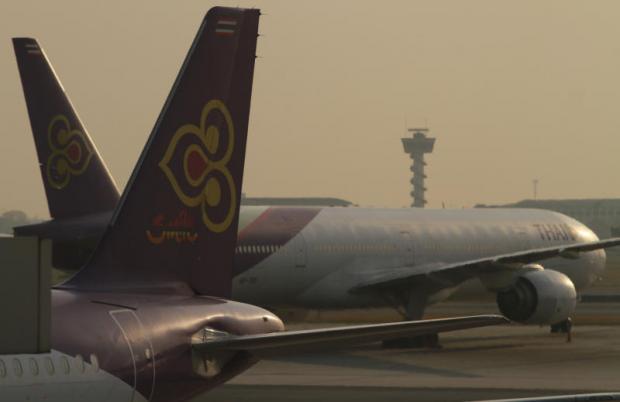
The second quarter was a weak period for the four SET-listed airlines, with only one declaring a (sharply lower) profit.
The worst performer in the April-June period, in terms of the size of the loss, was Thai Airways International (THAI), while Asia Aviation Plc (AAV) remained profitable.
Nok Air was in the red as widely expected, while Bangkok Airways' loss was surprisingly wider than projected.
Fierce competition, higher jet fuel prices, lower fares and increased excise tax on jet fuel used for domestic flights were attributed as key factors for dragging down financial performance in the quarter, even though the overall air traffic through the country kept rising.
The financial performance of those SET-listed airlines, more than 6.4 billion baht in total, was in sharp contrast with the rest of the world.
Initial financial results of airlines sampled by the International Air Transport Association (IATA) in the second quarter have been more robust than earlier in the year, as well as being higher than in the same period of 2016.

Thai airline performance
THAI: The flag carrier posted a greater net loss of 5.2 billion baht, compared with a 2.91-billion-baht loss recorded in the same period last year, as it failed to live up to its vow for profit making.
The showing tipped the airline to a 2.03-billion-baht loss for the first six months of the year, a reversal from a 3.09-billion-baht profit in the same period of 2016.
The latest results will make it more difficult for the airline to build on last year's improvement.
Last year, the airline managed to return to the black with just 47 million baht in earnings, compared with a 13-billion-baht loss in 2015.
The airline blamed a 20.1% year-over-year rise in jet fuel prices and a 10.9% drop in passenger yield as major contributors to the negative performance.
It was also faced with other issues such as losses from foreign exchange and the dilution of its ownership share in the budget airline Nok Air.
But the airline achieved good demand in the quarter, with traffic up 21.9% on a 7.1% capacity increase.
Second-quarter revenue rose 9.6% to 45.2 billion baht, while load factor was up 9.5 points to 78.5%, which the carrier said was the highest in a decade.
AAV: The majority shareholder of Thai AirAsia (TAA), Thailand's largest low-cost carrier, made 170.6 million baht in net profit in the second quarter, down 60% from the same period last year.
The slow recovery of Chinese passenger traffic caused by the zero-dollar tour scam clampdown and fierce market rivalry were blamed.
Lower second-quarter net profit dragged down total net profit for the first half of the year to 740 million baht, about half the prior-year amount of 1.43 billion.
Second-quarter revenue was 8.33 billion baht with a load factor average of 86%, up three percentage points year-on-year, and 4.69 million passengers flown.
Nok Air: The 13-year-old budget airline declared a second-quarter loss of 749 million baht, which was smaller than the 864 million loss incurred in the same quarter last year.
The airline blamed higher operating costs, driven largely by rising jet fuel prices, as a major factor.
Higher excise tax on jet fuel used for domestic flights, which represent the bulk of Nok Air's service, added 916 million baht to its fuel bills, up 38.9%.
But second-quarter revenue was up 14.1% at 3.38 billion baht, while the numbers of passengers carried declined 4% to 1.97 million.
Bangkok Airways: The regional airline made a loss of 521 million baht in the April-June period, 365% more than in the same period last year, when it posted a loss of 112 million baht.
Its total second-quarter revenue fell 1.2% to 5.98 billion baht as intensifying competition caused fares to drop.
Passenger yield, measured by revenue passenger-kilometre, was 4.25 baht, down 8.3% from the same period last year.
The second quarter's load factor fell to 62.7%, compared with 64.5% in the previous period.
But the number of passengers on scheduled flights with the airline in the second-quarter grew by 4.5% to 1.29 million.
The poor second-quarter performance dragged down the airline's first-half profitability to a mere 44.4 million baht, compared with 1.46 billion recorded in the first half of 2016.
First-half revenue decreased 2.7% to 13.5 billion baht with an average load factor of 67.1% and 2.91 million passengers carried.
Global airline performance
A sample of 24 major airlines in three regions picked by IATA showed a combined net profit of US$6.4 billion (213 billion baht) in the second quarter, compared with $5.78 billion in the previous period.
IATA analysts said the increased profitability suggested that the squeeze on profit margins from higher costs and weak yields peaked in Q1.
Indeed, whereas the industry-wide EBIT (earnings before interest and tax) margin fell in year-on-year terms in Q1 2017, IATA's sample indicated that the margin increased to 13.2% in the second quarter of 2017, up from 12.7% in the second quarter of 2016.
Meanwhile, having trended downwards since 2013, the latest monthly data suggests that passenger yields have started to trend upwards.
Exchange-rate-adjusted yields were broadly unchanged from their year-ago level in May.
Global airline share prices fell in July, driven by a decline in the North America index. Having seen airline shares outperform global equities over the past year, July's decline appears, in part, to reflect profit-taking by investors.
Meanwhile, Brent crude oil prices rose back above $50 a barrel in July, ending the month nearly 10% higher than they started it.
Passenger and freight demand growth posted their strongest first half of the year since 2005 and 2010, respectively.
The seasonally adjusted passenger load factor remained broadly stable, close to an all-time high over the same period, while the freight load factor recovered to its highest level in more than two and a half years, according to IATA.